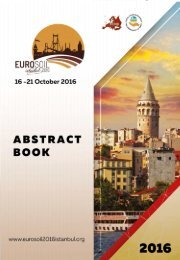Create successful ePaper yourself
Turn your PDF publications into a flip-book with our unique Google optimized e-Paper software.
144 Agricultural and Natural Research & Reviews
cultivar. In the study, Gamborg B-5 was used as a culture medium with 0.1 mg
L -1 NAA (Naphthalinacetic acid) and 0.2 mg L -1 Kin (Kinetin), and callus tissues
were obtained from the leaves of cuttings grown in-vitro. Callus tissues, which
were subcultured twice with 21-day intervals, were exposed to 254 nm UV-C
light at a distance of 10 cm from the source for 10 and 15 min in Petri dishes
in a sterile cabinet after the second subculture. After application, callus tissues
were incubated in dark conditions and their phenolic compounds were measured
at 24, 48, and 72 hours. Based on the results of the study, it can be said that
UV irradiation is effective in inducing the formation of phenolic compounds
in the callus tissues of this grape cultivar, and this effect is closely related to
the treatment time (Çelik et al., 2020). In another study, the effect of ‘Karaerik’
grape cultivar on the stimulation of anthocyanin production in callus cultures
after exposure to ultraviolet (UV) radiation was determined. The method
described by Çelik et al., (2020) was used for grape cultivar, and according
to the results, it was determined that UV radiation stimulated anthocyanin
production in the tissues of this grape cultivar (Oğuz et al., 2020). On the other
hand, there are studies on the post-harvest preservation of the ‘Karaerik’ grape
cultivar (Güleryüz & Çeleçi 1988; Karadoğan et al., 2005; Keskin et al., 2015).
In these studies, sulfur dioxide (SO 2
) generators were applied to ‘Karaerik’
grape cultivar and their effects on quality and storability were investigated.
According to the analyzes and observations made at the end of each month on
grapes stored at -1 - 0°C temperature and 87-92% relative humidity for three
months, the controls did not last even until the end of the first month and rotted,
cracked and lost their marketing quality. Although the best preservation is
provided with two-stage American fumigant papers, the application of bags has
been deemed more appropriate for the region, as it is cheap, easy to obtain,
and provides a level of preservation close to the two-stage American fumigant
papers (Güleryüz & Çeleçi 1988). In another study, the effectiveness of hot
water application was researched on the rooting of the cuttings and breaking of
dormant buds of the ‘Karaerik’ grape cultivar. The basal and apical parts of the
cuttings were exposed to 60 o C hot water for 5 min and the rooting of the cuttings
was considerably delayed compared to the control. Additionally, by exposing
the apical part of the cutting to hot water, bud break was delayed, whereas by
exposing the basal part of the cutting to hot water, bud break was early (Odabaş
2010). Keskin et al. (2015) determined the effects of hot water (55°C for 5 min)
and UV-C applications (254 nm wavelength from 100 (0.25 kJ/m 2 ) cm distance
for 4 minutes) for protection of fruit quality and prevention of decay as well as
extension of storage period in Karaerik cultivar. All clusters were stored at 0±






